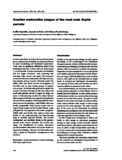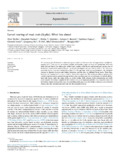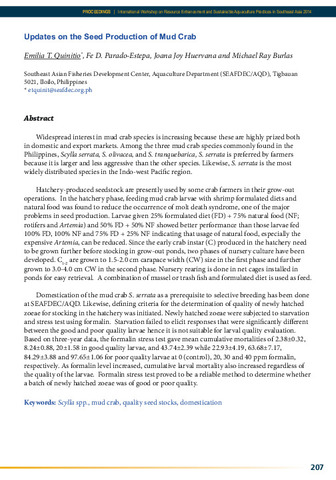Ovarian maturation stages of the mud crab Scylla serrata

View/Open
Date
2007Page views
544Metadata
Show full item recordCited times in Scopus
63 readers on Mendeley
Share
Abstract
Ovarian maturation in adult wild-sourced and pond-grown Scylla serrata (Forsskål) was determined based on gross morphology and histological appearance. There were no significant differences noted in the histological features of both wild and pond-reared S. serrata females. Ovarian maturation was classified into five stages: immature, early maturing, late maturing, fully mature and spent. The immature ovaries are thin and translucent to off white and contain oogonia, primary oocytes with large nuclei. The follicle cells were found around the periphery of the lobes and an area among groups of oogonia and oocytes. The follicle cells gradually enclosed the oocytes. The early-maturing ovaries were yellow and small yolk globules started to appear in larger oocytes. In late-maturing ovaries, the colour became light orange and lobules were apparent. Yolk globules occurred in the cytoplasm with larger globular inclusions towards the periphery, while follicle cells were hardly recognizable. Fully mature ovaries were orange to deep orange and had swollen lobules. Large yolk globules were apparent in the entire cytoplasm. Follicle cells were hardly seen. Spent ovaries were similar to the early-maturing and late-maturing stage in partially spawned females. The ovarian development was correlated closely to the gonadosomatic index, oocyte diameter, and ovarian histology. The classification of ovarian maturation provides baseline information for further studies on reproductive biology. Likewise, the information provides a guide for broodstock management in the hatchery.
Suggested Citation
Quinitio, E. T., de Pedro, J., & Parado-Estepa, F. D. (2007). Ovarian maturation stages of the mud crab Scylla serrata. Aquaculture Research , 38(14), 1434-1441. https://doi.org/10.1111/j.1365-2109.2007.01650.x
Subject
Taxonomic term
Collections
- AQD Journal Articles [1248]
Related items
Showing items related by title, author, creator and subject.
-
Larval rearing of mud crab (Scylla): What lies ahead
Waiho, Khor; Fazhan, Hanafiah; Quinitio, Emilia T.; Baylon, Juliana C.; Fujaya, Yushinta; Azmie, Ghazali; Wu, Qingyang; Shi, Xi; Ikhwanuddin, Mhd; Ma, Hongyu (Elsevier, 2018)The increasing global demand for mud crabs (genus Scylla) and threats to the wild populations highlight the urgency of fully rearing them in captivity. Despite considerable progress in mud crab production, most crab farms ... -
Mud crab pond and pen culture
Rodriguez, Eduard M. (University of the Philippines Aquaculture Society, Inc, 2001) -
Updates on the seed production of mud crab
Quinitio, Emilia T.; Parado-Estepa, Fe D.; Huervana, Joana Joy; Burlas, Michael Ray (Aquaculture Department, Southeast Asian Fisheries Development Center, 2015)Widespread interest in mud crab species is increasing because these are highly prized both in domestic and export markets. Among the three mud crab species commonly found in the Philippines, Scylla serrata, S. olivacea, ...



